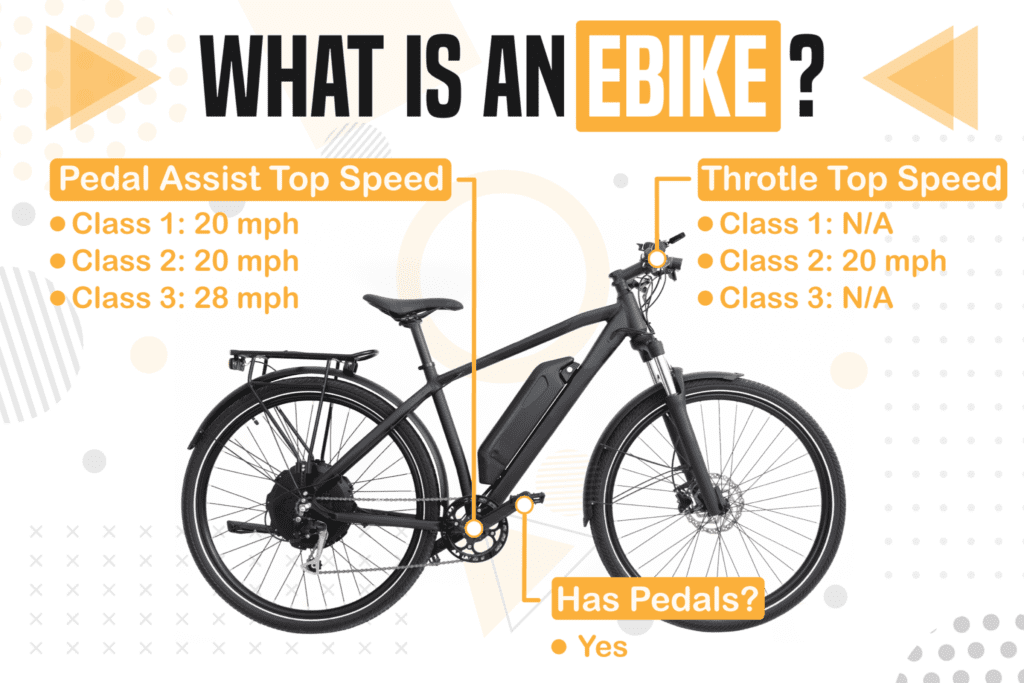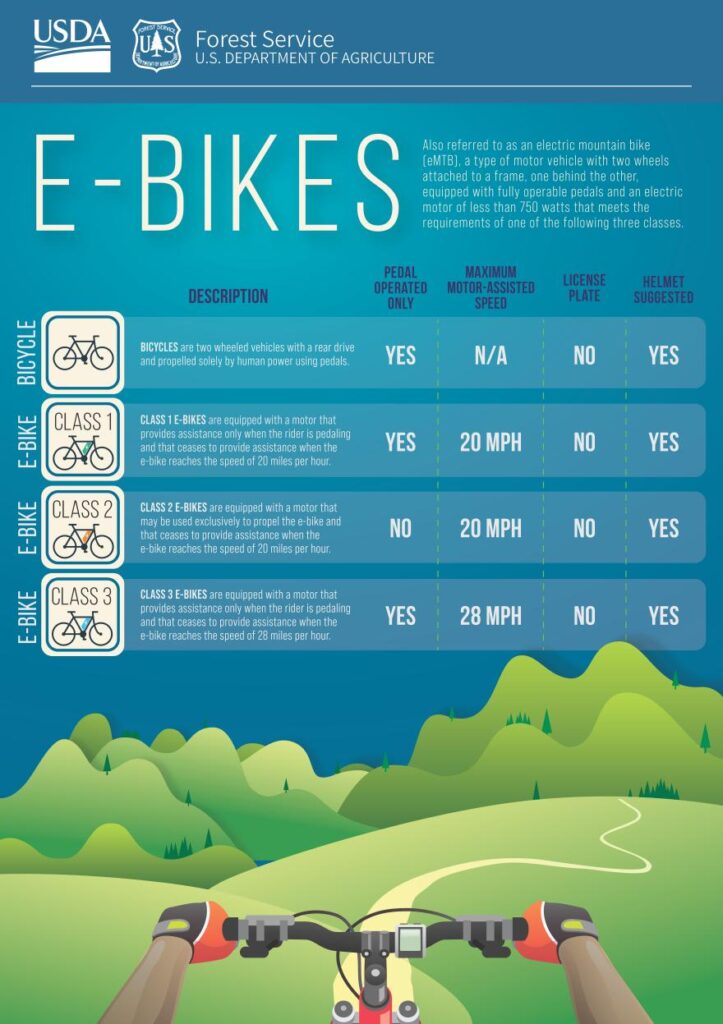WHAT IS AN E-BIKE?

DEFINITION OF AN ELECTRIC BICYCLE
The Consumer Product Safety Commission defines a low-speed electric bicycle as …
“a two- or three-wheeled vehicle with fully operable pedals and an electric motor of less than 750 watts (1 h.p.), whose maximum speed on a paved level surface, when powered solely by such a motor while ridden by an operator who weighs 170 pounds, is less than 20 mph.”
The CPSC adopted this definition in 2003 and vehicles that meet its definition are subject to the CPSC’s regulations for bicycles that are solely human powered. The effect of this definition is that lowspeed electric bicycles that comply with the definition are regulated by the CPSC for their production, initial sale, and recall. There is not a well-developed regulatory scheme for electric bicycles that do not meet the CPSC definition.
In Hawai‘i, e-bikes are classified as “low-speed electric bicycles.” Riders must acquire registration and be at least 18 years old. Those aged 15 and older can operate an e-bike as long as it’s registered under a household member. Anyone under the age of 16 must wear a helmet. E-bikes are permitted anywhere traditional bicycles can be ridden, bike paths included. See official legal definition for Hawai‘i here.
In the US, electric bikes are categorized into three e-bike classes based on three main criteria:
top speed, type of assistance, and motor power.
Class 1
Class 1 E-bike
20 MPH
Pedal-Assist Top Speed
✓⃝ Has operable pedals
• NO throttle
<750 Watt
• Registration fee: $30 (one-time)
✓⃝ legal to register and ride as a bicycle in Hawaiʻi
Class 2
Class 2 E-bike
20 MPH
Pedal-Assist Top Speed
✓⃝ Has operable pedals
✓⃝ Has throttle
<750 Watt
• Registration fee: $30 (one-time)
✓⃝ legal to register and ride as a bicycle in Hawaiʻi
Class 3
Class 3 E-bike
28 MPH
Pedal-Assist Top Speed
✓⃝ Has operable pedals
• May have throttle
• <750 Watt
❌ Not legal to register as a bicycle in Hawaiʻi

In Hawai‘i, if it goes faster than 20mph (with the rider not having to pedal), is equipped with a motor more than 750 Watts, or it does not have operable pedals, it is NOT legally considered an e-bike and should only be operated on private lands where you have permission.
HAWAI‘I ELECTRIC BIKE AND MOPED REBATE
The e-bike and electric moped rebate program makes rebates of up to $500 or 20% of the retail price available for eligible purchases of newly purchased electric bicycles and electric mopeds. The statute authorizing this program is HRS §196-7.8
Applications open at 12 a.m. Tuesday, Feb. 28, 2023. The online application can be found at https://arcg.is/1rvTTX2
Hard copy applications may be requested by calling (808) 831-7931.
The following restrictions apply:
- Only valid on purchases of new electric bicycles capable of speeds of no more than twenty-eight miles per hour, and electric mopeds.
- Purchase must be made at a retail store on or after July 2, 2022.
- Rebate amount is limited to the lesser of $500 or 20% of the retail price.
- No individual shall receive more than $500 in total rebates each fiscal year.
- The rebate application and supporting documentation must be submitted within 1 year of purchase. Failure to apply within twelve months of the date of purchase shall constitute a waiver of the right to claim the rebate.
- Applications that do not meet program criteria will not be considered.
- The Department reserves the right to verify purchase.
- The Department is not liable to pay any rebate if sufficient funds are unavailable.
Program Criteria:
- Applicant must be 18 years of age or older, and can prove one of the following:
- Participation in a low-income assistance program such as the Supplemental Nutrition Assistance Program or Section 8
- Do not own a motor vehicle with four or more wheels
- Current enrollment in a school, college, or university
For more information, visit hidot.hawaii.gov/hawaii-electric-bike-and-moped-rebate or call (808) 831-7931 for a hard copy (of the application for the eBike and eMoped rebate authorized in Act 306, SLH 2022).
Questions? Contact DOT.ebike.rebate@hawaii.gov for more details.
For current and prospective electric bicycle and electric moped riders
Wear a properly fitted and fastened helmet. For bike helmets, HDOT recommends using the CDC Bike Helmet Safety guide to pick out a good helmet. For moped helmets, look for weight, thickness, sturdy chinstraps, as well as “DOT” and manufacturer’s labels (e.g., Snell or ANSI) to help in selecting a safe helmet. In Hawai‘i, the law states that anyone riding a bicycle (electric or conventional) under the age of 16 years old must wear a properly fastened helmet.
Do not “pack” or carry passengers. Applicable laws here and here.
Safety reminders
About e-bike riding in Hawai‘i:
Just like conventional bicycles, electric bicycles are allowed to be operated on Hawai‘is roadways and in bicycle facilities. All on-street bicycle infrastructure (such as bike lanes, protected bike lanes, bike boxes, etc.) is created just for people on bicycles (no cars, motorcycles, or segways), and therefore available to all e-bike riders to use as well.
Check out the §291C-145 Riding on roadways and bikeways legal text here.
NOTE ON E-BIKE ETIQUETTE: These bicycle-only facilities are built for pedaling people to have a place they feel comfortable to cruise along in, so be sure to practice good e-bike etiquette before passing a slower cyclist:
- Give a clear head’s up in advance (audible “passing on your left” is perfect!)
- Slow your speed down & give them space when you go around them
Don’t want to stick to the slower speeds & confines of a bike lane? That’s cool, the open road is for bikes too! Just make sure you’re following all the general rules of the road – stopping at red lights & stop signs, going with the flow of traffic, signal your intentions before making a lane change or turn, make sure you drive with lights on when it’s dark… you get the picture!
Fast-moving vehicles are not for sidewalks. In Hawai‘i, sidewalk riding (e-bike or traditional bicycle) is legally allowed in residential areas (as long as the bicyclist is going under 10mph, yielding to pedestrians, and alerting them before passing). This being said, we encourage cyclists to operate their vehicles on the roads so that pedestrians can have full use of the sidewalk. Check out the §291C-148, §15-18.7 Riding on sidewalks legal text here.
